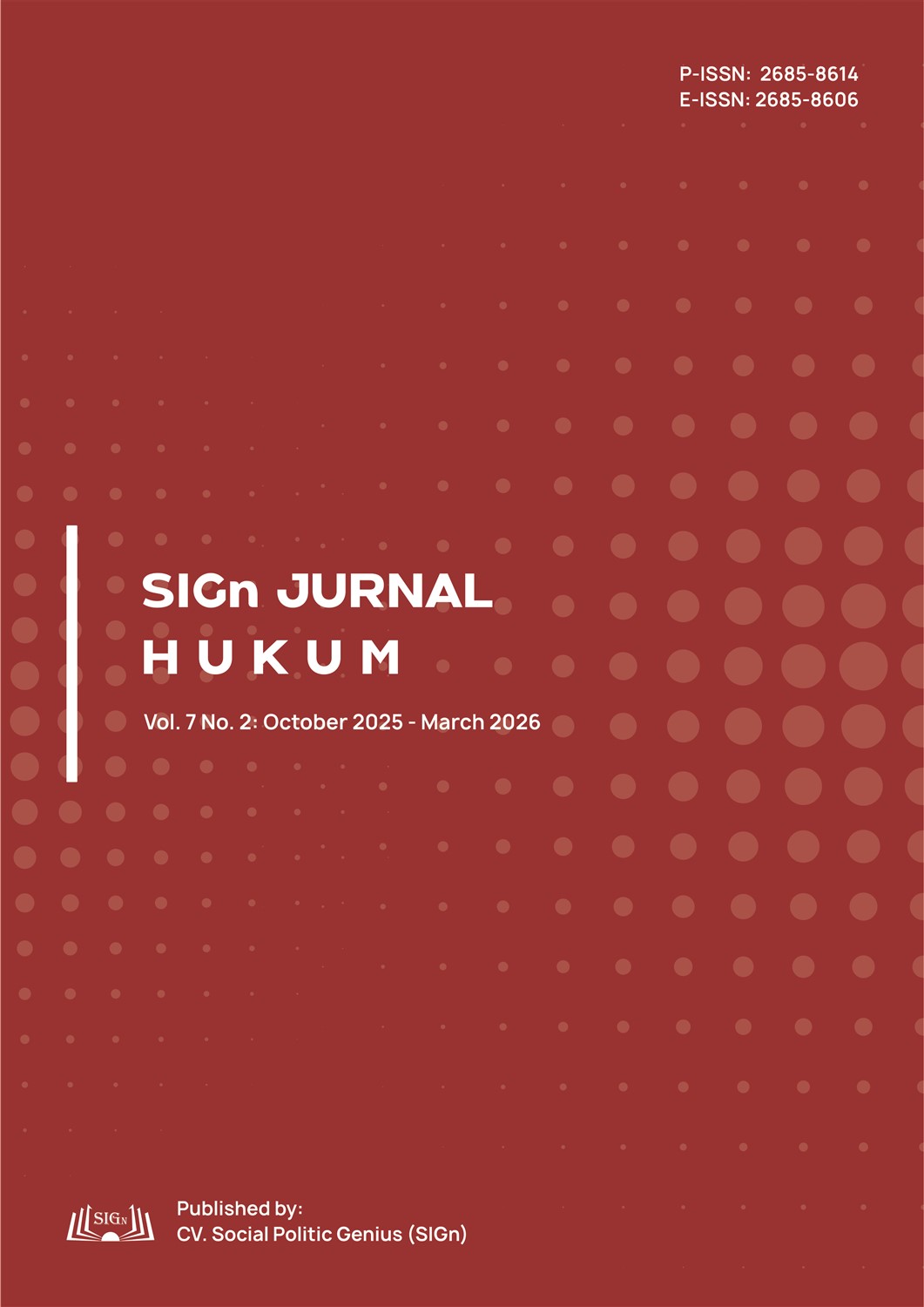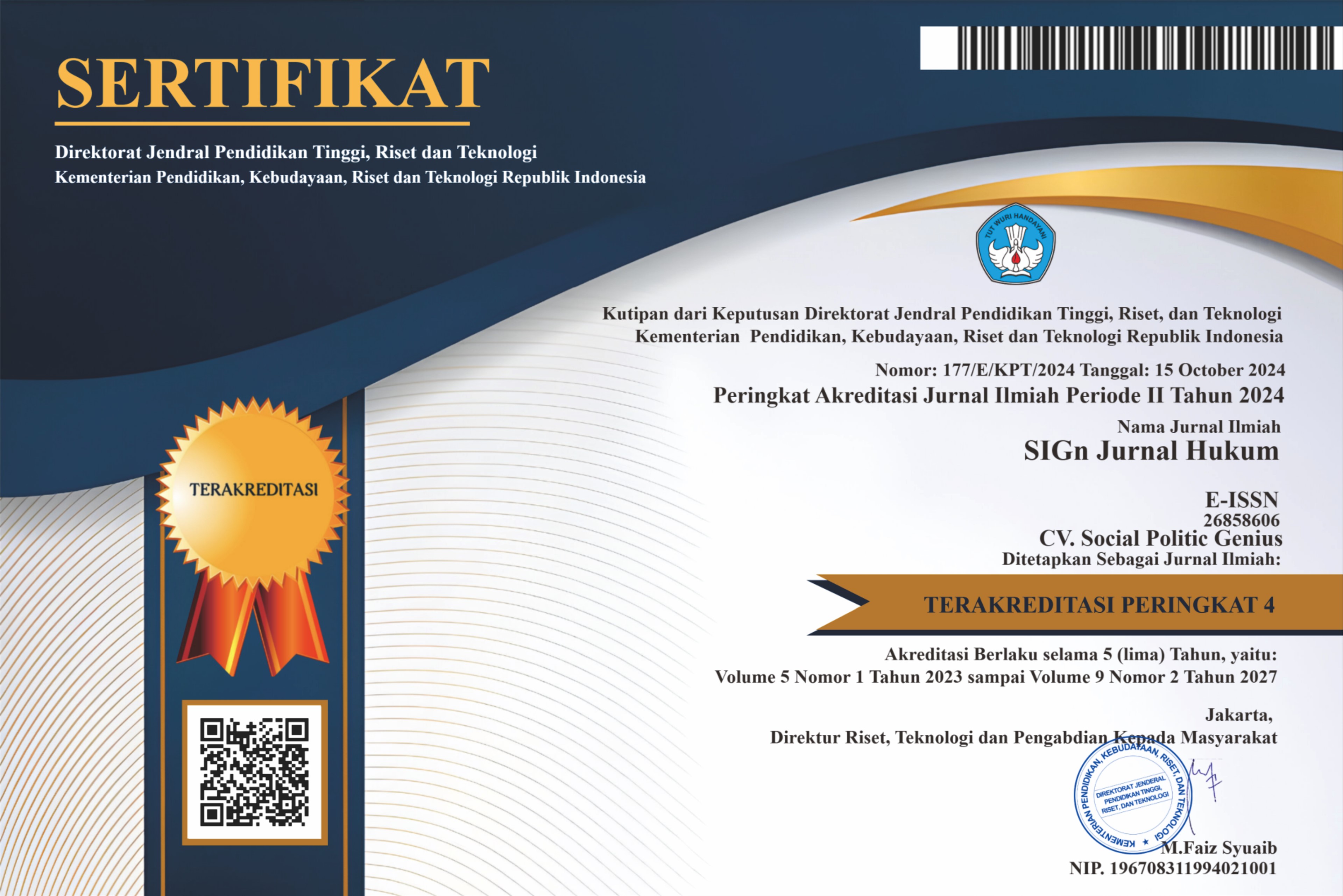The Qualification of Jarimah Ta’zir for Child Exploitation: A Case Study of Forced Labor at the Muara Parlampungan Gold Mine
Abstract
This research examines the phenomenon of child exploitation in the informal gold mining sector of Muara Parlampungan Village. This practice is opposed to the principles of child protection in Islam. Amid the ideal narrative of children as a divine trust whose dignity must be preserved, the on-the-ground reality reveals the systematic coercion of school-aged children, who are forced to work in high-risk conditions to support their families’ economy. The purpose of this study is to analyze this practice from the perspective of Islamic criminal law (fiqh jinayah) and to formulate a religio-legal (syar’i) qualification for the act. Using a juridical-empirical approach and a qualitative method, primary data were collected through observation and in-depth interviews with child victims, religious figures, and community leaders. The results reveal that children are forced to work 12-hour days in a hazardous environment. These conditions constantly threaten their physical and psychological safety, resulting in the deprivation of their fundamental right to education and inducing deep trauma with the potential for lifelong effects. An analysis based on the higher objectives of Islamic law (Maqashid al-Syariah) proves that this act directly undermines three fundamental objectives: the preservation of life (hifz al-nafs), the intellect (hifz al-‘aql), and progeny (hifz al-nasl). Based on this systematic harm, the study concludes that this practice of child coercion qualifies as a criminal offense (jarimah) falling under the category of a discretionary punishment (ta’zir). This qualification provides the state with full legitimacy to undertake legal intervention. The research recommends a hybrid law enforcement model that combines rehabilitative sanctions for parents with comprehensive restorative programs for child victims to break the cycle of exploitation.
Downloads
References
The 1945 Constitution of the Republic of Indonesia. https://www.dpr.go.id/dokumen/jdih/undang-undang-dasar
Aulia, G., Saragih, Y. M., & Zarzani, T. R. (2024). Pekerja Anak dalam Perspektif Hukum Pidana dan Hukum Syariah: Sebuah Kajian Komparatif. Jurnal Ilmiah Ilmu Pendidikan, 7(2), 1598-1607. https://doi.org/10.54371/jiip.v7i2.3958
Az-Zuhaili, W. (2011). Fiqih Islam Wa Adillatuhu: Hak-Hak Anak, Wasiat, Wakaf, dan Warisan (Trans. by A. H. Al-Kattani et al., Volume 10). Gema Insani.
Baharudin, B., & Adnan, I. (2024). Analisis Ketenagakerjaan Pekerja di Bawah Umur dalam Perspektif Hukum Islam dan Undang-Undang No. 13 Tahun 2003. Journal of Law and Administrative Science, 2(2), 14-49. https://doi.org/10.33478/jlas.v2i2.21
Damayanti, I., Dewi, C. I. D. L., & Karyoto, K. (2024). Peran Hukum dalam Mencegah Eksploitasi Anak dalam Kerja Anak dan Perdagangan Manusia. Jurnal Sosial dan Sains, 4(6), 446-455. https://doi.org/10.59188/jurnalsosains.v4i6.1372
Ente, H. F. (2024). Penerapan Sanksi Hukum terhadap Pelaku Ekspolitasi Anak Kota Gorontalo Tinjauan Hukum Pidana dan Fikih Jinayah. Hukum Inovatif: Jurnal Ilmu Hukum Sosial dan Humaniora, 1(4), 257-275. https://doi.org/10.62383/humif.v1i4.795
Fadila, Y. A., & Khayatudin, K. (2022). Tinjauan Yuridis Pelindungan Pekerja Anak di Indonesia dalam Perspektif Konvensi Hak Anak. Yustitiabelen, 8(2), 143-166. https://doi.org/10.36563/yustitiabelen.v8i2.563
Government Regulation in Lieu of Law of the Republic of Indonesia Number 1 of 2016 on the Second Amendment to Law Number 23 of 2002 on Child Protection (State Gazette of the Republic of Indonesia of 2016 Number 99, Supplement to the State Gazette of the Republic of Indonesia Number 5882). https://peraturan.go.id/id/perppu-no-1-tahun-2016
Government Regulation in Lieu of Law of the Republic of Indonesia Number 2 of 2022 on Job Creation (State Gazette of the Republic of Indonesia of 2022 Number 238, Supplement to the State Gazette of the Republic of Indonesia Number 6841). https://peraturan.go.id/id/perppu-no-2-tahun-2022
Hakmad, I. (2021). Sanksi Pidana Penelantaran Anak di Indonesia. Al-Qanun: Jurnal Kajian Sosial dan Hukum Islam, 2(2), 143-156. Retrieved from https://jurnal.uinsu.ac.id/index.php/alqanun/article/view/9492
Harahap, S. H. A. R. D. (2024). Eksploitasi Anak Penghibur Jalanan di Medan: Analisis Hukum Islam dan UU Perlindungan Anak Tahun 2014. Empirisma: Jurnal Pemikiran dan Kebudayaan Islam, 33(2), 345-364. https://doi.org/10.30762/empirisma.v33i2.2483
Hidayat, D., Fatmariza, F., Muchtar, H., & Indrawadi, J. (2023). Fenomena Anak Bekerja di Tambang Emas. Journal of Education, Cultural, and Politics, 3(2), 237-243. https://doi.org/10.24036/jecco.v3i2.237
Irwansyah. (2020). Penelitian Hukum: Pilihan Metode & Praktik Penulisan Artikel. Mirra Buana Media.
Jusrianto, J., & Nur, H. (2021). Dampak Pendidikan Anak di Bawah Umur yang Bekerja pada Sektor Informal. Journal Social Society, 1(1), 21-27. https://doi.org/10.54065/jss.1.1.2021.51
Lajnah Pentashihan Mushaf Al-Qur’an. (2022). Qur’an Kemenag. Ministry of Religious Affairs of the Republic of Indonesia. https://quran.kemenag.go.id
Law of the Republic of Indonesia Number 23 of 2002 on Child Protection (State Gazette of the Republic of Indonesia of 2002 Number 109, Supplement to the State Gazette of the Republic of Indonesia Number 4235). https://www.dpr.go.id/dokumen/jdih/undang-undang/detail/322
Law of the Republic of Indonesia Number 13 of 2003 on Manpower (State Gazette of the Republic of Indonesia of 2003 Number 39, Supplement to the State Gazette of the Republic of Indonesia Number 4279). https://www.dpr.go.id/dokumen/jdih/undang-undang/detail/196
Law of the Republic of Indonesia Number 35 of 2014 on Amendment to Law Number 23 of 2002 on Child Protection (State Gazette of the Republic of Indonesia of 2014 Number 297, Supplement to the State Gazette of the Republic of Indonesia Number 5606). https://www.dpr.go.id/dokumen/jdih/undang-undang/detail/1617
Law of the Republic of Indonesia Number 17 of 2016 on Enactment of Government Regulation in Lieu of Law Number 1 of 2016 on the Second Amendment to Law Number 23 of 2002 on Child Protection Into Law (State Gazette of the Republic of Indonesia of 2016 Number 237, Supplement to the State Gazette of the Republic of Indonesia Number 5946). https://www.dpr.go.id/dokumen/jdih/undang-undang/detail/1680
Law of the Republic of Indonesia Number 6 of 2023 on Enactment of Government Regulation in Lieu of Law Number 2 of 2022 on Job Creation Into Law (State Gazette of the Republic of Indonesia of 2023 Number 41, Supplement to the State Gazette of the Republic of Indonesia Number 6856). https://www.dpr.go.id/dokumen/jdih/undang-undang/detail/1825
Lira, M. A. (2023). The Father’s Responsibility for the Fulfillment of Child Support Post-Divorce. SIGn Jurnal Hukum, 5(2), 276-291. https://doi.org/10.37276/sjh.v5i2.291
Lubis, I. I., Zahara, F., & Syahputra, A. (2023). Analisis Pandangan Hukum Islam Terhadap Eksploitasi Anak dalam Menopang Perekonomian Keluarga di Kota Medan (Studi Kasus Kantor Perlindungan Anak Medan Johor). Jurnal Interpretasi Hukum, 4(2), 177-182. https://doi.org/10.22225/juinhum.4.2.7571.177-182
Maulidna, R. N. N., & Sundary, R. I. (2021). Perlindungan Hukum terhadap Pekerja Anak dihubungkan dengan Hak Atas Pendidikan Studi Kasus di Provinsi Jawa Barat. Jurnal Riset Ilmu Hukum, 1(1), 62-66. https://doi.org/10.29313/jrih.v1i1.202
Miles, M. B., Huberman, A. M., & Saldaña, J. (2014). Qualitative Data Analysis: A Methods Sourcebook (Third Edition). Sage.
Munawir, Y. (2023). Problem Perlindungan Hukum Terhadap Anak yang Bekerja (Analisis Data Profil Anak Indonesia 2021). Media of Law and Sharia, 4(4), 301-324. https://doi.org/10.18196/mls.v4i4.37
Nabilla, E., & Musyafa’ah, N. L. (2024). Eksploitasi Anak Sebagai Pengamen Jalanan di Kabupaten Madiun dalam Tinjauan Viktimologi dan Hukum Islam. Muqaranah, 8(2), 137-154. https://doi.org/10.19109/rbqke841
Nadhifah, D. A., Ismail, Y., & Ariesta, W. (2025). Analisis Yuridis Terhadap Larangan Mempekerjakan Anak dalam Perspektif Tujuan Hukum. Interdisciplinary Explorations in Research Journal, 3(2), 582-593. https://doi.org/10.62976/ierj.v3i2.1254
Nahuddin, Y. E. (2022). Tindakan Mantan Suami Tidak Membayar Biaya Pemeliharaan (Hadhanah) kepada Anak dalam Perspektif Perlindungan Anak. Jurnal Penelitian dan Pengembangan Sains dan Humaniora, 6(3), 463-471. https://doi.org/10.23887/jppsh.v6i3.50988
Nasrullah, N. (2023). The Escalation of Child Trafficking in Makassar: A Criminological Analysis. SIGn Jurnal Hukum, 5(1), 182-194. https://doi.org/10.37276/sjh.v5i1.284
Pramasela, S., & Zarkasih, H. (2023). Pertanggung Jawaban Orangtua Terhadap Anak yang Bekerja untuk Membantu Perekonomian Keluarga Perspektif Maqashid Syariah dan UU No 35 Tahun 2014 Perubahan Atas UU No 2002 tentang Perlindungan Anak (Studi Kasus di Kecamatan Seteluk Kabupaten Sumbawa Barat). Al-Ihkam: Jurnal Hukum Keluarga Jurusan Ahwal Al-Syakhshiyyah Fakultas Syariah IAIN Mataram, 15(2), 226-253. https://doi.org/10.20414/alihkam.v15i2.11369
Pratama, R. S. (2021). Eksploitasi Anak yang Dijadikan Pengemis oleh Orangtuanya di Kota Surabaya. Court Review: Jurnal Penelitian Hukum, 1(4), 23-33. https://doi.org/10.69957/cr.v1i04.50
Puspitasari, A. R., Fatmariza, F., Montessori, M., & Muchtar, H. (2024). Fenomena Pekerja Anak di Tambang Batubara. Journal of Education, Cultural, and Politics, 4(2), 476-484. https://doi.org/10.24036/jecco.v4i2.463
Qamar, N., & Rezah, F. S. (2020). Metode Penelitian Hukum: Doktrinal dan Non-Doktrinal. CV. Social Politic Genius (SIGn).
Rivanie, S. S., Komuna, A. P., Putra, A. A., Utama, P. F., & Muzakkir, A. K. (2021). Protection of Children as Perpetrators of Criminal Act Stimulated by Pornography Based on Indonesian Laws. Musamus Law Review, 4(1), 1-15. https://doi.org/10.35724/mularev.v4i1.3759
Riyad as-Salihin. (n.d.). Sustentation of the Members of the Family (294). Sunnah. https://sunnah.com/riyadussalihin:294
Rizki, M. A., Azizah, V. R., & Fuady, M. Z. (2024). Eksploitasi Anak melalui Konten Youtube Menurut Undang-Undang dan Hukum Pidana Islam. Ma’mal: Jurnal Laboratorium Syariah dan Hukum, 5(2), 190-209. https://doi.org/10.15642/mal.v5i2.357
Sahih al-Bukhari. (n.d.). The Woman is a Guardian in Her Husband’s House (5200). Sunnah. https://sunnah.com/bukhari:5200
Sampara, S., & Husen, L. O. (2016). Metode Penelitian Hukum. Kretakupa Print.
Sinaga, M. H., Yani, S., Salsabila, E., Hasibuan, H., & Sinaga, D. F. (2023). Permasalahan Umum yang Dialami Anak Jalanan. Didaktik: Jurnal Ilmiah PGSD STKIP Subang, 9(2), 868-875. https://doi.org/10.36989/didaktik.v9i1.799
Sitorus, R. G. S., & Mukhsin, A. (2024). Pemenuhan Nafkah Istri yang Ditinggal Suami untuk Menjadi TKI. Ranah Research: Journal of Multidisciplinary Research and Development, 6(5), 1772-1783. https://doi.org/10.38035/rrj.v6i5.1063
Copyright (c) 2025 Sri Anggini Lubis, Abd. Mukhsin

This work is licensed under a Creative Commons Attribution 4.0 International License.

















